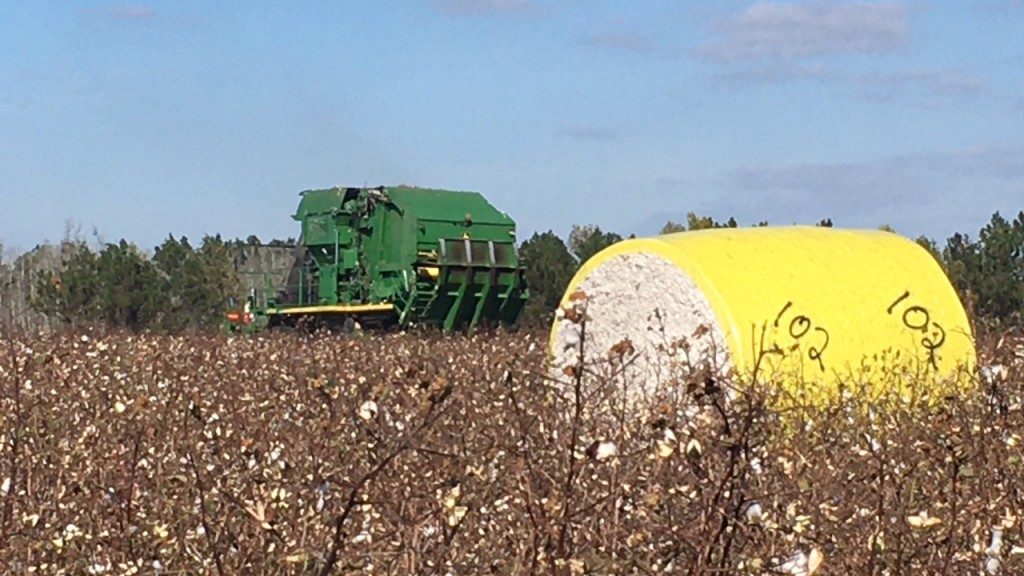Plant parasitic nematodes, to include the southern root-knot, the reniform, the sting, and the Columbia lance nematodes, are important pests that reduce yields in our cotton fields across Georgia every year. Seedling disease, especially when caused by Rhizoctonia solani, and, to a lesser degree, Pythiumand other fungal pathogens, is a potential problem in every field every year. To combat nematodes and protect seed and seedlings against disease, essential decisions must be made very early in the season, prior to or at the time of planting. Prior to closing the furrow, growers have opportunities to protect their seed and plant-stands in ways that have impact on the yield potential for the remainder of the season. The following is a “laundry list” of actions that a grower MUST consider in order to protect the seeds and cotton seedlings.
1.There are several important fungal pathogens that can cause both pre-emergent and post-emergent stand loss ina cotton field. In Georgia, Pythiumspecies are can be commonly associated with “pre-emergent damping-off” where the seedling dies before cracking the soil surface. The most common seedling disease of cotton in Georgia is “soreshin” caused by Rhizoctonia solani. “Soreshin” is a post-emergent seedling disease and is easily recognized by seedlings that wilt and die within a week or two. Protecting the young plants from seedling diseases is a three-step process. The first step, where possible, is to plant high-quality seed with a strong, documented, germination rate. It is difficult, if not impossible to recover when poor-quality seed is planted. The second step is to plant under conditions that result in rapid, uniform germination and vigorous growth. Cool, and wet soils, or planting just ahead of a cold rain, can slow germination and plant growth. Such gives the fungal pathogens, “the bad guys”, the chances to play catch-up with the peanut seeds and seedlings, infect and then damage them. The third step is to ensure that the seeds are well-protected with a fungicide seed treatment. All commercial seed will come pre-treated with a “base” fungicide package. The base package varies among different seed companies, but is always composed of a mix of three-to-four fungicides that have proven efficacy against common pathogens like Rhizoctonia, Pythium, and Fusarium. From my studies in about four-out-of-five years, use of the “base” fungicide treatment alone results in stands and yields similar to where additional fungicide seed-treatments or in-furrow fungicides are applied. However, investment in extra “insurance” with additional seed-treatments or in-furrow fungicides may be beneficial. Growers are most likely to observe a benefit from “extra” treatments where risk to seeding disease is elevated, such as when planting into cool and wet soils or conservation tillage. Additional seed protection may also be beneficial when planting at reduced seeding rates or where seed-quality is thought to be an issue.
2.Protecting seeds and seedlings from death and loss of vigor is an important task for growers. In addition to the steps outlined above, growers can use additional seed-treatments or in-furrow applications to compliment the performance of base seed-treatments and to further protect against seedling diseases. “Extra” fungicide seed-treatments are more convenient to use; in-furrow fungicides may be more effective as they can be used to treat the seed and the soil surrounding the seed as well.
3.Nematodes can be devastating to a cotton crop. Southern root-knot and sting nematodes are especially problematic in sandier areas of a field. Reniform nematodes tend to be more problematic in “heavier” soils which have higher levels of silts and clays. The best way to determine if nematodes are a problem in a field is by taking soil samples at harvest, or, in some cases, by examining roots of affected plants. Areas in a field, especially sandier areas of a field, where plants remain small and stunted despite adequate moisture and soil fertility, may be affected by nematodes. Growers can minimize damage from southern root-knot nematodes by a) planting a root-knot nematode variety, b) by fumigating with Telone II, c) by using Velum Total (14-18 fl oz/A) or AgLogic 15G (6-7lb/A) in-furrow at planting, or by using one of several seed-treatment nematicides. Growers can apply Vydate C-LV or Return XL at the 5th-to-7thtrue-leaf stage to compliment the earlier nematicide treatments. As there are currently no commercial varieties with resistance to the reniform, Columbia lance, or sting nematodes, growers must use nematicides to protect their crop.
4.Fusarium wilt, caused by Fusarium oxysporumfsp. vasinfectum, is a significant problem in some fields in Georgia. Here in the southeastern United States, Fusarium wilt occurs as a complex of the fungus and nematodes, especially the root-knot and sting nematodes. Effective management of Fusarium wilt requires that growers protect their cotton with effective nematicides, such as those noted above.
5.Bacterial blight has not been a significant problem since 2017; however the problem can still occur in some fields under favorableconditions. The only tactic to fight bacterial blight is to plant a bacterial-blight resistant variety.Growers have the opportunity prior to, and at planting time to manage important problems that include seedling diseases and seed rots, nematodes, Fusarium wilt, CBR, and bacterial blight. Growers are encouraged to carefully consider their options and to make informed decisions to best protect their cotton crop at this critical part of the season.
